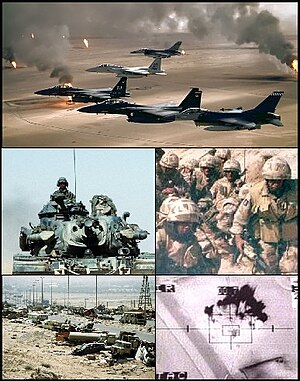 A war fought for oil is going to make oil impossibly high-priced, in a world where simply living will become harder for billions of people. Image via Wikipedia
A war fought for oil is going to make oil impossibly high-priced, in a world where simply living will become harder for billions of people. Image via Wikipedia
. . . The U.S. armed forces consume about 14 million gallons of oil per day, half of it in jet fuel. Humvees average 4 miles per gallon, while an Apache helicopter gets half a mile per gallon. The Iraq War, which George W. Bush launched in part to protect vital oil supplies, consumed oil at a phenomenal rate. . . .U.S. forces in Iraq during 2007 consumed 40,000 barrels of oil a day, all of which was transported into the war zone from other countries. The U.S. Air Force uses 2.6 billion gallons of jet fuel a year, 10 percent of the U.S. domestic market.By the end of 2007, according to a report from Oil Change International by Nikki Reisch and Steve Kretzmann, the Iraq War had put at least 141 million metric tons of carbon dioxide equivalent into the air, as much as adding twenty-five million cars to the roads. The Iraq War by itself added more greenhouse gases to the atmosphere than 60 percent of the world's nations. . . .The mechanization of the military provided many more opportunities to increase carbon dioxide production during the world wars of the early twentieth century. World War II's Sherman tank, for example, got 0.8 miles per gallon. Seventy-five years later, tank mileage had not improved: the 68-ton Abrams Tank got 0.5 miles per gallon. Fighter jets' typical subsonic fuel consumption is 300 to 400 gallons per hour at full thrust (or 100 gallons per hour at cruising speed) during hundreds of hours' training, or combat missions. Blasting to supersonic speed on its afterburners, an F-15 Fighter can burn as much as four gallons of fuel per second.During the 1950s and 1960s, U.S. B-52s were in the air at all times, on the theory that an airborne fleet would prevent the Soviet Union from obliterating the entire U.S. nuclear armed armada on the ground. Each of these B-52s burned hundreds of gallons of fossil fuel per hour while aloft. The B-52 Stratocruiser, with eight jet engines, consumes 500 gallons of jet fuel per minute, or 3,000 per hour. In a few minutes, a B-52 consumes what an average automobile driver uses in a year.What I'd like to know is, how many years of riding a bike to work would it take for me to offset one F-15 flying for an hour? Assuming that my bike replaces a car that gets 25 miles per gallon, my daily commute of five miles would use a gallon a week. That's nearly seven years to fuel a fighter jet at top thrust for one hour.We don't have that kind of time. Thermal inertia delivers the results of atmospheric change roughly a half century after our burning of fossil fuels provokes them. The weather today is reacting to greenhouse gas emissions from about 1960. Since then, the world's emissions have risen roughly 400 percent. The Cold War, the Vietnam War, the Gulf War, the Iraq War, and the Afghanistan War have all played their part. But we haven't even felt their full environmental effects yet. . . .Global warming has already accelerated beyond even the predictions of pessimistic scientists. The polar ice caps are dissolving and the permafrost is melting, injecting more carbon dioxide and methane into the air. And as the ice caps melt, the sun reflects off the dark water instead of the white snow, and the atmosphere heats all the faster. This summer, large swaths of tundra have been burning, adding still more greenhouse gases to the atmosphere. Before the hot wind blows in our face, we need to recognize the environmental insanity of war.The Pentagon wants to go "green," though—and not only with its light bulbs. It is also using solar energy at some of its bases, and is even trying to manufacture a synthetic fuel for the B-1 bomber. But we don't need a "green" military with high-mileage tanks, or bombers flying on biofuel. Anyway, war, for the foreseeable future, will depend largely on fossil fuels. As the Pentagon now tells us, we have no national security without climate security. War has become the ultimate environmental oxymoron.Instead, we need to address the reasons countries and groups go to war: nationalism, religious fanaticism, tribalism, poverty—and scarcity of resources, like oil. And we can't do that by consuming that oil in spasms of nationalism.Peacemakers are often assumed to be naive dreamers. Given the environmental circumstances, however, a timely end to war is not naive, but necessary. The Earth can no longer afford war.

![Reblog this post [with Zemanta]](http://img.zemanta.com/reblog_e.png?x-id=6c111062-1306-4b4b-ae59-8f61e846835f)




1 comment:
Excellent post, which highlights one of the most important sunbjects of our time. International organizations should collect more data to scientifically quantify the carbon footprint of Wars past and present. In a real ecological sense, any war is impacting us through environmental degradation, higher CO2 levels, and consumption of scarce resources. I commend you for bringing this discussion to the forefront. Best, Cory M. Grenier
Post a Comment